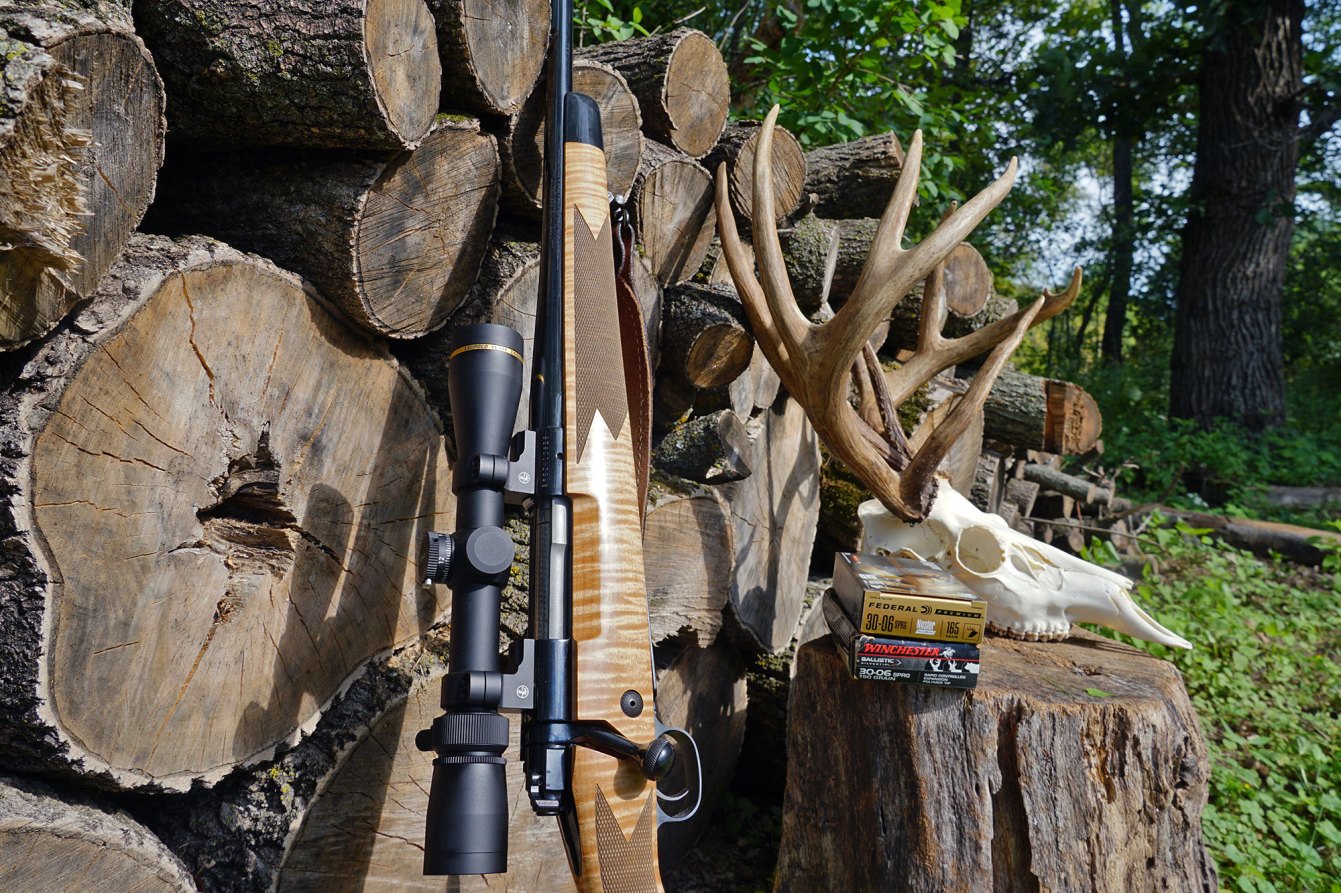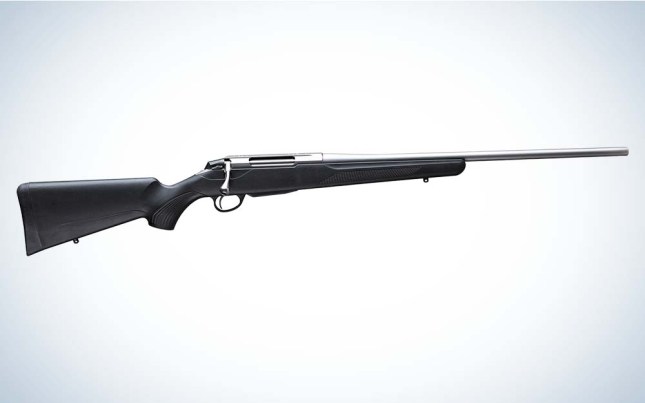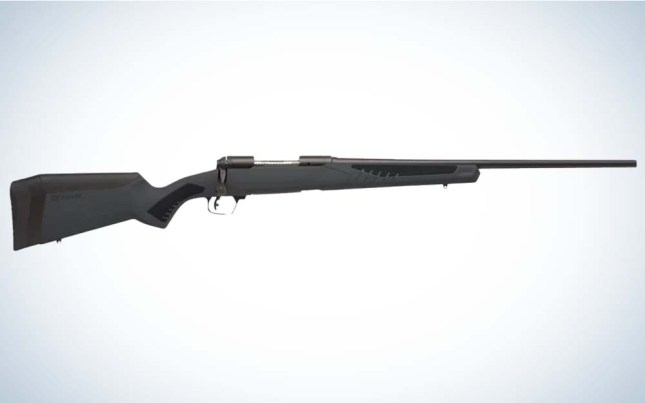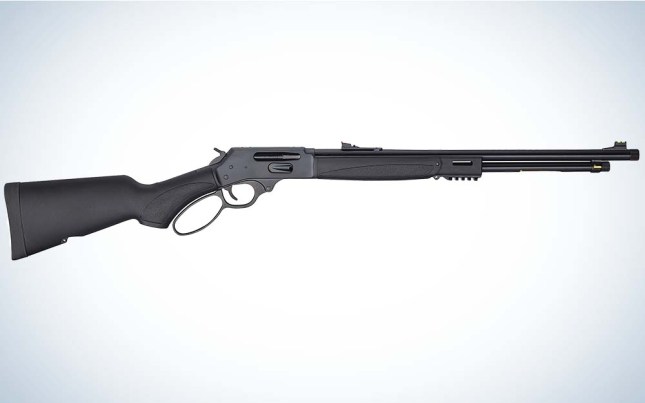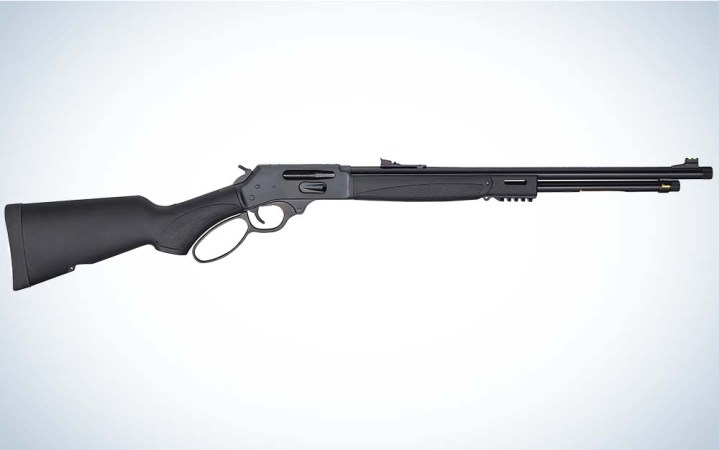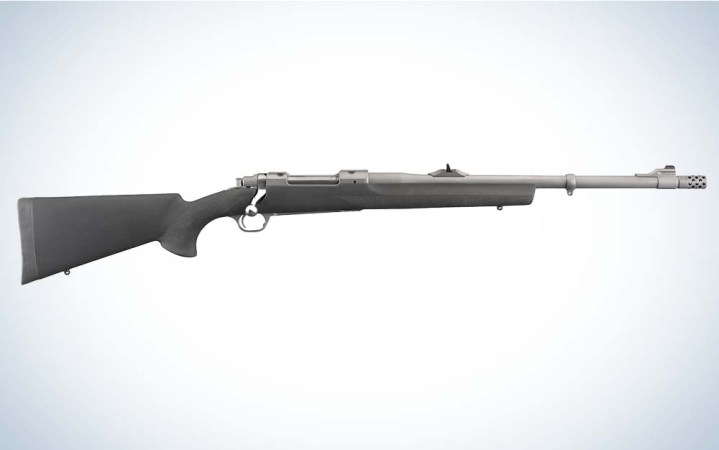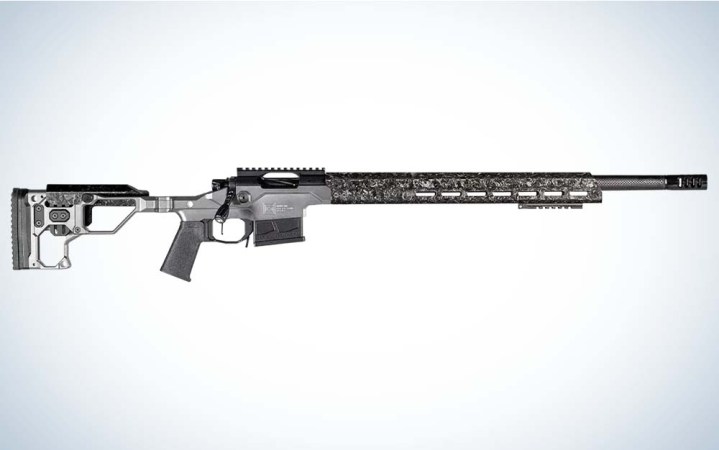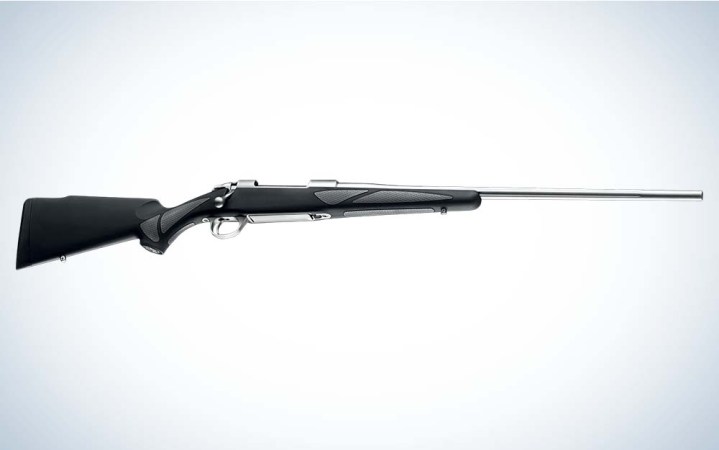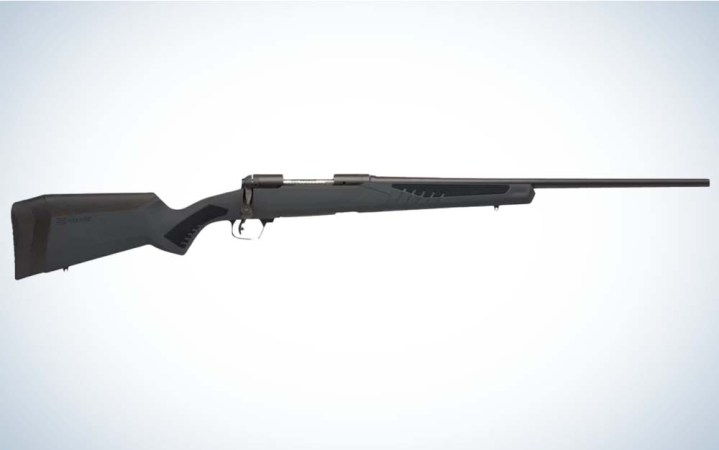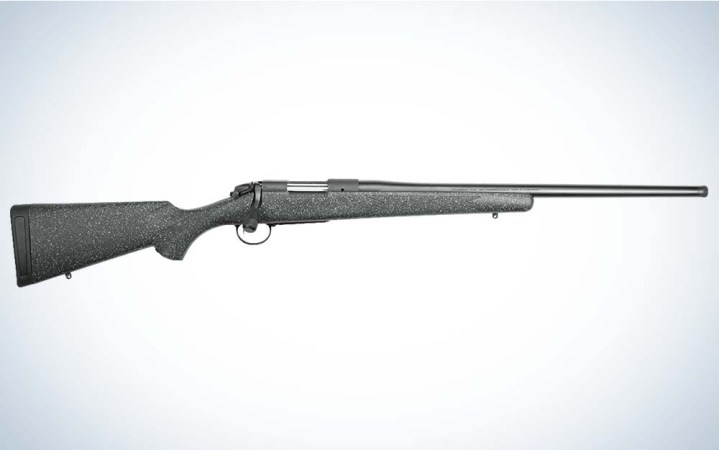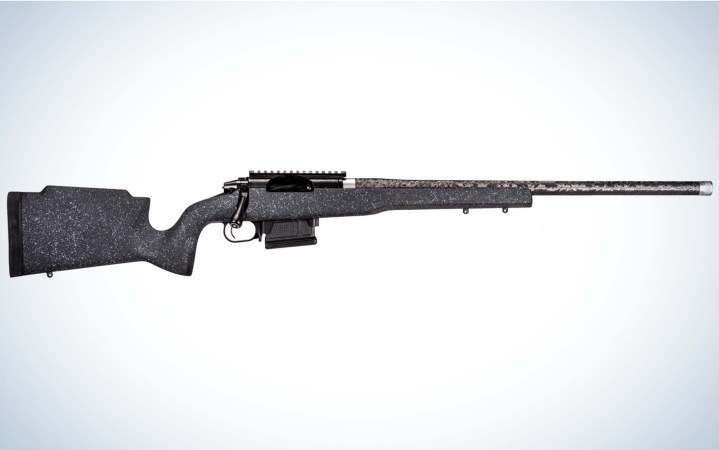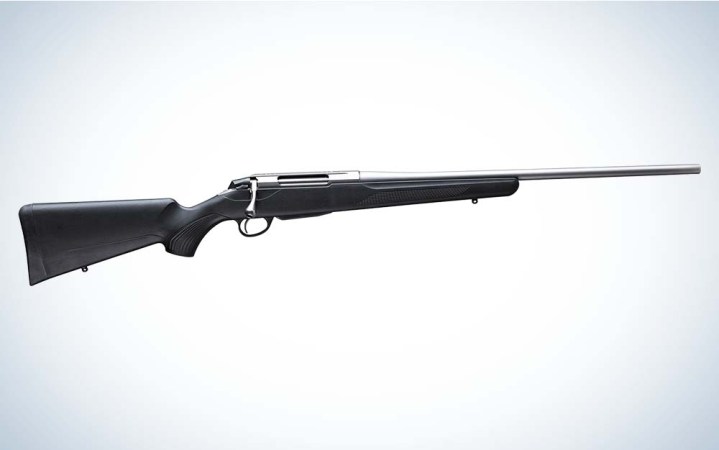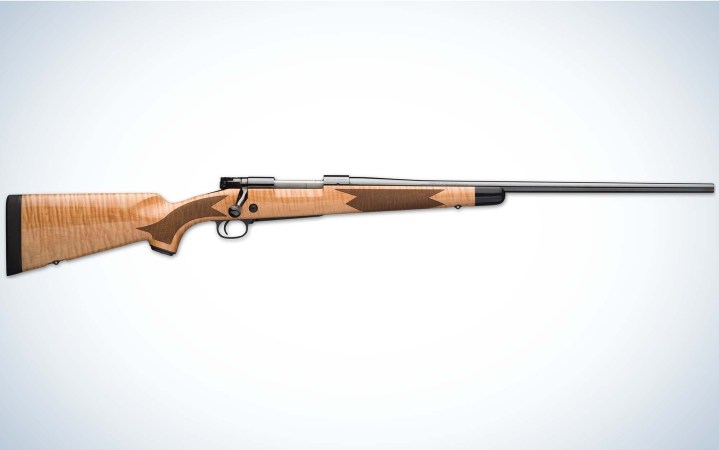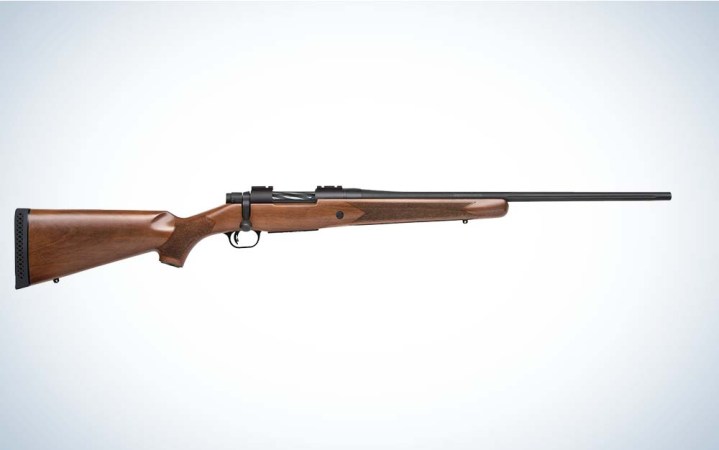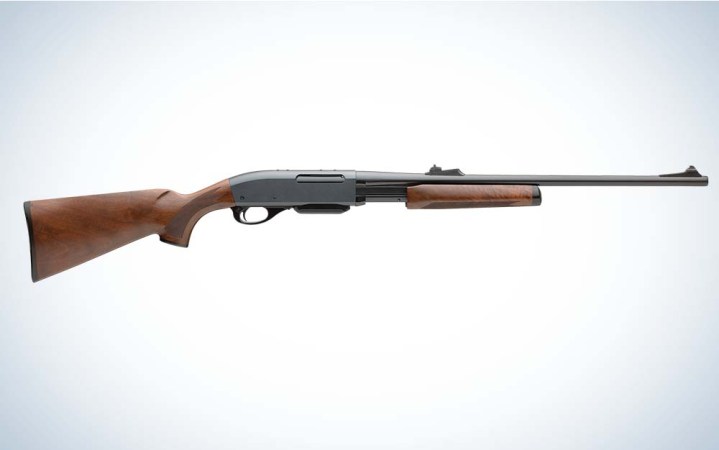We may earn revenue from the products available on this page and participate in affiliate programs. Learn More ›
As everyone knows, the best deer rifle is the one you already own. There might be other rifles like it, but that one is yours and therefore is superior to the rest. But every now and then, someone needs—or wants—to buy another deer gun. Perhaps you’re familiar with the sensation? From personal experience I can say this has only happened to me 10 or 12 dozen times over the years.
So if you’re a new hunter who is looking to invest in one of the best deer hunting rifles, or a gun nerd who has a hard time saying “no,” this list is for you.
- Northwoods: Henry Lever Action X Model
- Alaska: Ruger Hawkeye Alaskan
- Beanfield Sniper: Christensen MPR
- Western Mountains: Sako 85 Finnlight
- Great Value: Savage 110 Hunter
- Southern Piney Woods: Bergara B14 Ridge
- Technical: Proof Research MTR
- Great Plains Stalker: Tikka T3x Lite Stainless
- Family Heirloom: Winchester Model 70 Super Grade
- Straight Wall Shooter: Mossberg Patriot
- Pennsylvania Stalwart: Remington 760 and 7600
How I Picked the Best Deer Rifles
I structured the list loosely based on geography and hunting style to give it a bit of variety and to help provide some ammunition to whoever finds themselves arguing with their significant other over the justification for buying a new gun. “But honey, I can’t take that rifle, I’m going hunting in Kansas…”
These are also deer rifles that my colleagues and I have shot, tested, and hunted with and have passed muster. We didn’t include any that we don’t have hands-on experience with. All but one of the rifles are currently in production, and most are affordable, though we threw in a couple that are worth saving for or aspiring to.
But the bottom line is that these rifles are ones you can rely on to handle any deer hunt you might encounter, whether that is on your family’s plot of land in farm country, in the snowy hardwoods in the North Country, in a stand of alpine timber, or in the distant rainforests of coastal Alaska.
Best Deer Hunting Rifles: Reviews and Recommendations
Northwoods: Henry Lever Action X Model
One sure sign of the decline of Western civilization is the scarcity of new lever-actions to choose from. Marlin is thankfully back on its feet, and is ramping up production. Henry Repeating Arms, however, hasn’t missed a beat since it was founded in 1996, and is adding new guns to its lineup at a pleasing clip.
The X Model in .30/30 is one of the more recent additions. While the bones of the X Model are rooted in tradition, the rifle is finished with modern hunters in mind.
It is stocked in a nearly indestructible synthetic material with recessed sling attachment points molded into the fore-end and butt stock. The fore-end also has a section of Picatinny rail up front to mount a light for night-time shooting applications. That section also has M-Lok slots to mount accessories compatible with that format.
The tubular magazine holds five rounds and can be loaded through the gate on the receiver or by dropping cartridges into the cutout at front end of the magazine tube.
It comes with a nice set of adjustable fiber optic sights but in keeping with modern tastes the receiver is drilled and tapped for mounting a scope.
Being chambered in .30/30 Win., the X Model will do its best work within 150 yards, but for most deer hunting that is plenty adequate. You can also get the X Model chambered in .45/70, .45 Colt, .357/.38 Spl., .44 Mag./.44 Spl as well if you want to go with a straight-wall cartridge.
Alaska: Ruger Hawkeye Alaskan
By many accounts, the small Sitka blacktails that live in Alaska are the finest table fare of any venison. While these little blacktails don’t require anything special in the way of shooting, the best deer rifle for this country takes into account the other critters in their neighborhood—coastal brown bears, which do require an adequate amount of gun to deal with.
The Hawkeye Alaskan is currently available in three chamberings, .375 Ruger, .338 Win. Mag., and .300 Win. Mag. The .300 is a good compromise cartridge for this thick brushy terrain, but if a hunter wanted to shoulder one of the other cartridges, it’s not as if the deer would notice. The rifle ships with a muzzle brake to help tame the recoil of these thumpers.
The Alaskan holds three rounds in its hinged-floorplate magazine, has as 20-inch barrel, and measures a handy 42 inches from muzzle to recoil pad. The Hawkeye is the heir to the old M77 Rugers and has a non-rotating full-length Mauser style claw extractor and a fixed-blade ejector. Those classic turn-bolt design features have been giving hunters the warm fuzzies since the late 1800s and will appeal to sportsmen who like traditional rifles.
The Alaskan comes with fixed sights geared toward dangerous game, with a shallow V rear express-style sight and a bold bead on the front post. But the Alaskan can easily accommodate a scope as well.
Even if you don’t hunt deer in bear country, this rugged rifle is a good option for those who live by the “use enough gun” and “can’t be too dead” mantras.
Beanfield Sniper: Christensen MPR
The term “beanfield rifle” was coined by former Outdoor Life shooting editor Jim Carmichel when reviewing the hyper-accurate bolt-actions made by master riflesmith Kenny Jarrett. Kenny is one of the godfathers of hunting rifle accuracy and incorporated benchrest rifle technology into his exquisite firearms.
Why “beanfield?” Well in some stretches of ag land down south those fields that deer favor can be many hundreds of yards in length, and when the beans have grown high, they don’t leave much of a deer’s body as a target. Thus, you had the need for a rifle that reaches out with pinpoint accuracy to guarantee success.
Jarrett still makes those wonderful rifles, but their stratospheric price tags—many are north of $10,000—put them out of reach of all but the well-heeled or ballistically irresponsible.
The Christensen MPR doesn’t look much like Kenny’s creations, but what it has in common is the ability to shoot tiny groups. When the MPR debuted I tested it and produced five-shot groups with factory ammo that averaged .557 inch across a wide variety of brands and bullet weights in 6.5 Creedmoor. Several of the loads I shot from Norma, Barnes and Hornady averaged in the .4s. Today, you can get it in .223 Rem., 6mm Creed, 6.5 Creed, 6.5 PRC, .308 Win., .300 PRC, or .338 Lapua Mag.
For beanfield hunting, the flat-bottomed fore-end makes for a stable platform when positioned in a blind or stand. Without question, it is one of the best lightweight long-range rifles in production.
It’s a modern, sexy looking rifle with lots of carbon fiber and an adjustable folding stock and will appeal to hunters who are sci-fi nerds. Though not cheap, it costs a fraction of the original beanfield rifle.
Western Mountains: Sako 85 Finnlight
There’s no shortage of mountain rifles to pick among for hunting deer in vertical terrain. The first criteria hunters consider is weight because a rifle that’s too heavy to lug uphill isn’t going to do you much good.
But there’s more to a quality mountain rifle than a sub-6-pound readout on a scale. A good mountain rifle must be able to handle awful weather, survive in an unforgiving rocky environment, and be able to deliver an accurate first-round shot on what might be the hunt of a lifetime.
The Sako Finnlight checks all these boxes through its rugged construction, excellent ergonomics, and superb accuracy. The Finnlight I tested a few years ago was chambered in .308 Win. and delivered 5-shot groups measuring less than .6 inches with factory Hornady ammo.
The fact that they were five-shot groups is key. To reduce weight most mountain guns have pencil-thin barrels that heat quickly and cause shots to walk and the groups to open up as the round count increases. For that reason, the accuracy guarantees for most rifles, especially mountain rifles, are based on three-shot groups. That the Finnlight was able to keep shooting tight groups even with a hot barrel is a testament to its quality.
The rifle comes with a smartly designed flush-mounted staggered magazine that’s easy to load and won’t accidentally get bumped and fall free of the action. The three-position safety next to the bolt shroud has a middle position that keeps the gun on safe but lets the shooter open the action to unload the rifle.
The Finnlight is available in numerous chamberings in addition to .308. You can have it in a number of great deer cartridges including .243 Win., .25/06 Rem., .270 Win., .260 Rem., .30/06, .300 Win. Mag., .300 WSM, .270 WSM, 6.5×55 Swede, 7mm-08 Rem., and 7mm Rem. Mag.
Great Value In a Deer Hunting Rifle: Savage 110 Hunter
Nothing warms the collective heart of the Outdoor Life gun test team than a great gun value. We’re lucky to live in an era with plenty of rifles that are budget friendly and accurate. While the Ruger American and Mossberg Patriot certainly deserve a spot on anyone’s list of smart buys, Savage Arms, more than any other modern company, has made accuracy and performance available to the masses.
I don’t know how many different iterations of the Model 110 have been built over the years—there’s been quite a pile of them—but the basic 110 Hunter is still the standard by which to measure a budget-conscious investment.
There are some cheaper guns on the market, but what makes the Model 110 Hunter so appealing are the upgrades that it comes with. That includes the AccuFit stock system which incorporates a bedding-block to create a solid connection between the stock and action, which helps with accuracy.
The stock also has modular sections to alter the length of pull and comb height. It’s a rifle that a young shooter grow with as their body fills out. The length of pull can adjust from 12.75 to 13.75 inches. It also lets a shooter fine-tune the stock dimensions for a better fit, which will translate to better performance in the field.
The rifle comes with Savage’s AccuTrigger, which is one of the original user adjustable designs to debut on a mass-market hunting rifle. In fairness, the quality of the AccuTriggers can vary, so it makes sense to spend time dry firing a sample in your local gun store before committing to a specific rifle.
The detachable box magazine holds four rounds in all cartridges except .300 Win. Mag., where it holds three. Chamberings include .243 Win., .25/06 Rem., 6.5 Creed, .30/06, .308 Win., 7mm Rem. Mag., 7mm-08, and, my favorite, .280 Ackley Improved.
The 110 Hunter isn’t as hardened against the elements as some other rifles, so some diligence and care is called for with the carbon steel barrel, especially if it is going to be exposed to the elements. Other than that, the rifle is ready to take a beating and keep placing accurate shots on game.
Southern Piney Woods: Bergara B14 Ridge
Some of the most pleasant deer hunts I’ve experienced have been down in the Piney Woods of the Southeast. Alabama’s Black Belt, in particular, with its fertile soils, cranks out impressive bucks and is great habitat for turkeys and upland birds as well.
The hunting tends to be civilized as long as the mosquitos aren’t out in force, but when a cold front rolls though you might find yourself dealing with some rougher conditions that run contrary to our notions of Southern hospitality.
The Bergara B14 Ridge fits this type of hunting to a tee. It is a well-mannered and capable bolt action that delivers solid performance at a good price and while it has plenty of nice touches it isn’t a flashy rifle by any means.
Depending on action length and chambering, the rifles weigh about 7.5 pounds unscoped, give or take a few ounces. Barrel lengths run from 18 to 24 inches, with most short-action cartridges using 22-inch barrels while standard-length chamberings have 24-inch tubes.
This middle-of-the-road configuration is perfect for 90 percent of deer hunting. The B-14’s heft and balance allow it to run easily from the shoulder and brought into play in a smooth, efficient manner.
Though the rifle is built in Spain—Bergara makes extremely nice barrels over there—it is configured with the American hunter in mind. The synthetic stock has “American classic” dimensions, with its flat comb, the metalwork is treated with black Cerakote finish for durability, and the muzzle is threaded 5/8-24.
Caliber choices include .243 Win., 6.5 Creedmoor, 6.5 PRC, .308 Win., 7mm-08 Rem., .270 Win., 7mm Rem. Mag, .30/06, .300 Win. Mag., and .300 PRC. The internal box magazine has a hinged floorplate and holds 4 rounds of the standard cartridges and 3 of the magnums. Because the 6.5 PRC and .300 PRC are chubby, the B-14’s magazine only holds two of them.
Technical Deer Hunting Rifle: Proof Research MTR
For the technically inclined deer hunter, Proof Research’s MTR (Mountain Tactical Rifle) is an intriguing option. It is a great example of a modern deer rifle that borrows heavily from the tactical and competition shooting world to create a high-performance rig that is accurate, portable, and able to handle the most demanding hunting conditions.
Proof uses a Zermatt Arms Origin action on the MTR, which is known for its remarkably tight tolerances, reliability, and accuracy. Proof, of course, puts one of its carbon-fiber barrels on the MTR and the mating of the Zermatt and barrel delivers exceptional accuracy. In fact, I’ve used this rifle in competition and know that it is able to place precise shots on distant targets under demanding time constraints and from practical field positions.
The stock is also of Proof’s design and is made of carbon-fiber as well. Depending on the cartridge, the naked rifle weighs about 6.5 pounds to a touch over 7 pounds. The stock has a raised comb and vertical pistol grip, both of which are common on tactical rifles. The comb helps align the shooter’s eye with larger optics that tend to sit higher on the rifle (the action has a full-length Picatinny rail) and the vertical grip enhances the shooter’s control over the rifle and the trigger pull.
The MTR uses detachable box magazines and will feed from AICS pattern mags. It ships with a single polymer magazine. The rifle feeds with dead-nuts reliability and can handle dust, moisture, and other debris without any issues.
The barrel is threaded 5/8-24 for a brake or suppressor and the rifle comes with a sub-MOA accuracy guarantee. Among the available cartridges are three short-barrel options. One is the 6 ARC with a 16.5-inch barrel, and the others are .308 Win. and .223 Rem. with 20-inch barrels. You can also get it in 6 Creedmoor, 6.5 Creedmoor, 6.5 PRC, 7mm Rem. Mag., .300 Win. Mag., and .300 PRC, all of which come with 24-inch barrels.
Great Plains Stalker: Tikka T3x Lite Stainless
It still amazes me to come across deer hunters who haven’t checked out a Tikka. When the company started making a serious push into the American market about 15 years ago, their virtues were still not widely known. But at this point Tikka’s praises have been sung loudly from the hilltops, yet there are still some poor souls who haven’t gotten the message.
For an all-around, do-anything deer rifle, the Tikka T3x Lite Stainless is as versatile a big-game rifle as you can find, especially considering its price. The Tikka’s bones are similar to those in its sibling brand Sako. Many parts of the Tikka are borrowed directly from the more expensive Sako, in fact.
The three-lug action runs smoothly, the magazine system is among the best you’ll find in terms of how easy it is to load and its reliability, and the general handling of the Tikka T3x is superb, which isn’t a surprise given that European hunters place great emphasis on how a rifle manages quick shots on running game.
In the Lite Stainless trim, the Tikka tips the scales at roughly 6.4 pounds, meaning that with a good light scope it will be easy to carry across any terrain.
This isn’t a fancy rifle with a lot of adornment. The barrel isn’t fluted, though the muzzle threaded 1×14. The black stock has textured panels molded into the grip and fore-end for a secure handhold, but otherwise is fairly plain.
But don’t let that fool you. This is a very capable gun and one of the best deer hunting rifles. I used one in Mongolia last year to make a very long and challenging shot on a sheep and never felt compromised by its basic design.
Cartridge options include .243 Win., 6.5×55 Swede, .270 Win., .30/06, 7mm Rem. Mag., .308 Win., 300 Win. Mag., 6.5 Creedmoor, and one of the best all-around big-game cartridges on earth, the 9.3×62.
Read our full Tikka T3X Lite review for more information.
Family Heirloom: Winchester Model 70 Super Grade
In a world of black rifles and synthetic stocks it is nice to see that some companies still make guns that harken back to deer hunting’s roots. Pretty much any kid who grew up in a deer-hunting family cast an envious eye toward their dad’s, or granddad’s, or uncle’s well-worn rifle hoping to inherit it someday.
Well, if you’re going to dream, dream big I say. The Winchester Model 70 Super Grade combines the iconic M70 action with drool-worthy wood and is the kind of gun that will get passed from one generation to the next.
The stock is made of AAAA Maple, and has a soft honey-colored hue with tiger-stripe figuring through the wood and a raised cheekpiece with a shadow line. The stock also has an ebony-tip and diamond-pattern checkering on the fore-end and grip that is both attractive and functional. A solid-black Pachmayr is a visual bookend to the ebony tip and imparts a harmonious look to the rifle.
Outdoor Life editor-in-chief Alex Robinson acquired one of these beauties last fall and had good things to say about it. Being a thoroughly traditional rifle, it delivered traditional accuracy, which is to say five shots in about 1.5 inches at 100 yards with select ammunition. Forget the social media boasting about half-inch groups (“all day long,” of course), that level of accuracy is more than sufficient for all but the most demanding deer hunts.
The Model 70 Super Grade comes with a hammer-forged barrel with a polished blue finish that’s even and well executed. The action is what Winchester calls a pre-’64 action, though in truth it is better made than the vintage M70s.
One upgrade is Winchester’s MOA trigger, which has a minimal amount of take-up for a clean crisp break. (Though there’s something to be said for a properly tuned old-school M70 trigger.) The action comes with a three-position safety and a jeweled bolt body as well.
If you want to go all-in on the vintage appeal of this rifle, get it chambered in .264 Win. Mag. with a 26-inch barrel. That will channel all your deer-hunting forefathers and make them smile from their place in the Happy Hunting Grounds beyond.
It’s also available in the very modern 6.8 Western as well as the usual suspects: .243 Win., 6.5 Creedmoor, .308 Win., .270 Win., .30/06, 7mm Rem. Mag., and .300 Win Mag.
Straight Wall Shooter: Mossberg Patriot
As more states that previously had not allowed use of centerfire rifle rounds for deer hunting relax their regulations so that straight wall cartridges can be taken afield, gun makers have responded with new offerings.
For a hunter who wants to take advantage of the recently introduced .350 Legend (basically a lengthened .357 Magnum that is geared for these straight-wall states) but doesn’t want to spend a lot of money to do so, the Mossberg Patriot is the best deal going.
The Patriot has made several of our best rifle lists (like our list of the best budget hunting rifles) over the years and it continues to impress us with its solid design and good accuracy at a price that can’t easily be beat.
Mossberg is chambering two rifles in .350 Legend, one a plain synthetic stock rifle that can be had for less than $400, and an upgraded version in walnut that costs a bit more. Other than the stock material and the price, they are the same.
Both have 22-inch barrels and take four-round detachable box magazines. The magazines are light and easy to load and clip in and out of the action without a fuss. The rifles have Mossberg’s user-adjustable LBA trigger that can be set to break between 2 and 7 pounds.
The bolts have spiral flutes on them which help the guns run a more smoothly and add a bit of visual flair to the rifle’s otherwise basic aesthetics.
The rifles come with cross-slot bases affixed to the receiver so one only needs to buy a pair of rings to mount a scope.
In my experience the accuracy of these rifles has been pretty good, though the .350 Legend isn’t a round designed to shoot small groups. You can expect five-shot groups to measure about 2-inches at 100 yards based on what I’ve seen .350 Legend factory ammo do so far. While that isn’t going to win you internet bragging points, it is a heck of an upgrade from the slug guns that the .350 Legend is displacing. Plus, with its softer recoil it is much more pleasant to shoot.
Pennsylvania Stalwart: Remington 760 and 7600
You can’t talk about the best deer rifles without including one of the all-time greats, the Remington 760 and 7600. It might not be in production today, but for hunters in Pennsylvania and other parts of the Northeast, these slide-action repeaters will forever have a place in deer camp.
The calling card of these rifles is their fast-handling and ability to deliver quick follow-up shots. Picture still-hunting through a stand of hardwoods and jumping a heavy buck from his bed and you have the scenario that the 760 and 7600 was designed for.
Most 7600s came with 22-inch barrels and a four-round magazine. The rotary bolt system is actuated by the two action bars connected to the fore-end and is as slick as a bobsled run.
Most are stocked in walnut, though Remington made synthetic stocked 7600s—but to me those all-black guns miss the point.
The 760 and 7600 have shotgun-like stock dimensions so they are optimized to be shot with the fixed sights on the barrel. The receivers on the 7600 are drilled and tapped to take a scope, however. If you go that route, consider adding a raised cheek piece to the stock to get correct alignment with the optic.
By modern standards, the triggers are pretty rough, but shotgun shooters will feel right at home with a 7600 in their shoulder.
Remington started building the 760s in 1952 up through 1981, after which the 7600 was rolled out. The Model 7600 was made from 1981 until the company went bankrupt for the second time a couple years back. The current management of Remington Arms (as the company is now called) still has the 7600 list on their web site, but I wouldn’t hold my breath waiting for new versions to be made any time soon given all the challenges that Big Green is facing.
You can still find them online and in used gun stores, however. The prices vary, but usually aren’t crazy. Even though the 7600 is beloved, it doesn’t carry around an inflated sense of its self-worth.
When production was halted, Remington was chambering the 7600 in .270 Win., .30/06, and .308 Win. But you can find some that were made in .243 Win., 6mm Rem., .35 Whelen and, my pick, .35 Remington.
FAQs About the Best Deer Hunting Rifles
The best rifle caliber for deer hunting is the one that you can shoot well and that uses a properly constructed bullet that will do its job. Some states mandate that deer cartridges must be .243 caliber (6mm) or larger, and that’s a good place to start. Any .243 Win. or 6mm Creedmoor with a good bullet is plenty enough for deer.
Stepping up in size, cartridges like the .25/06 and 6.5mm Creedmoor are smart options that don’t recoil very hard. And you will never go wrong with 7mm and .30-caliber rounds either. The 7mm-08, .308 Win., .30/06, 7mm Rem. Mag. and others are fabulous rounds for whitetail and mule deer.
Stepping up in size, cartridges like the .25/06 and 6.5mm Creedmoor are smart options that don’t recoil very hard. And you will never go wrong with 7mm and .30-caliber rounds either. The 7mm-08, .308 Win., .30/06, 7mm Rem. Mag. and others are fabulous rounds for whitetail and mule deer.
There’s absolutely no need to go with a .300 Win. Mag. unless you’re in bear country or just love getting socked in the shoulder when you pull the trigger.
This is an excellent question that deserves a long answer, but I’ll hit on some of the high points. Of course, you want a rifle with acceptable accuracy. In most parts of the country that means a rifle that can shoot 5-shot groups that measure two inches (or less) from center to center at 100 yards. But you also want a rifle that you can shoulder and swing easily and that allows you to work the bolt comfortably while the rifle is mounted.
If you’ll be hunting in weather that is predominantly bad or in rough terrain, a rifle with a synthetic stock and some type of protection on the metal work (like Cerakote) is worth prioritizing.
Lastly, the rifle should be something that you enjoy looking at, since deer hunting involves a lot more sitting around and walking than it does shooting.
There are a bunch of good options for someone looking for a deer hunting rifle on a budget. The Savage 110 Hunter listed here is an excellent choice, but you can get a Ruger American or Mossberg Patriot for even less money. Another good option to consider is the CVA Cascade.
Final Thoughts On The Best Deer Hunting Rifles
Selecting your best deer hunting rifle involves weighing a lot of factors. First and foremost is your budget. Start with a price tag you can live with that gets you a good rifle and quality scope and work from there.
Ideally, you want a rifle that you will enjoy shooting and will be able to shoot a lot without getting beat up. Excessive recoil can lead to flinching, which can be tougher to eradicate than rats from the NYC subway system. Better to avoid this potential problem and shoot a rifle and cartridge that is comfortable. With today’s selection of excellent hunting bullets, mild cartridges like the .243 Win., 7mm-08, and 6.5 Creedmoor are deadly on big game.
Lastly, you want a reliable rifle that will perform under the most adverse circumstances. All the rifles listed here check that box, meaning you could take any one of these afield with a high degree of confidence.
- Northwoods: Henry Lever Action X Model
- Alaska: Ruger Hawkeye Alaskan
- Beanfield Sniper: Christensen MPR
- Western Mountains: Sako 85 Finnlight
- Great Value: Savage 110 Hunter
- Southern Piney Woods: Bergara B14 Ridge
- Technical: Proof Research MTR
- Great Plains Stalker: Tikka T3x Lite Stainless
- Family Heirloom: Winchester Model 70 Super Grade
- Straight Wall Shooter: Mossberg Patriot
- Pennsylvania Stalwart: Remington 760 and 7600
